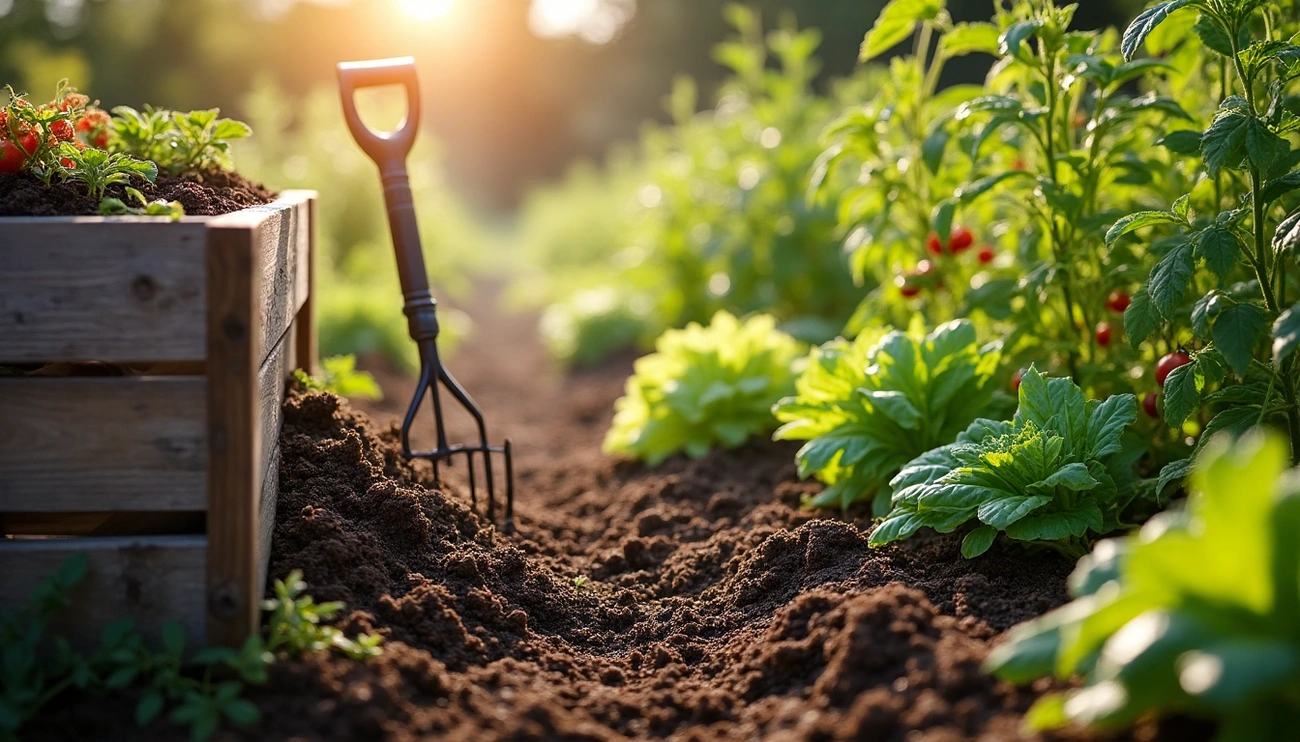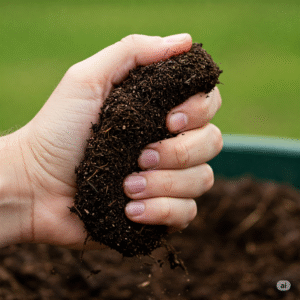Discover 5 Powerful Benefits: Why Composting is a Must-Have for Your Garden
This water retention advantage is just the beginning. The benefits of composting extend far beyond moisture control—it can boost plant growth by up to 50% in grasslands and increase vegetable yields by 24-32% for crops like lettuce and kohlrabi. Moreover, the advantages of composting include diverting more than 30% of typical waste from landfills, saving approximately $54 per ton in disposal costs. In fact, compost helps combat soil degradation, which affects about 33% of soils worldwide, by enhancing soil porosity and adding essential nutrients like nitrogen, phosphorus, and potassium.
We’ve been using compost in our gardens for years, and the results speak for themselves. Whether you’re a seasoned gardener or just starting out, understanding how to harness these composting benefits can transform your garden while contributing to a healthier planet. Let’s explore how you can start composting and enjoy these remarkable advantages in your own backyard.
Table of Contents
What is Composting and Why It Matters
Image Source: Perkiomen Watershed Conservancy
“Composting is a win-win; we are reducing our waste and feeding our gardens. You are helping to keep the carbon in the soil, and in turn, you are giving life back to your soil.” — Karen Mitchell, Consumer Horticulture Extension Specialist, Purdue University
Composting is the managed biological decomposition of organic materials by microorganisms under aerobic (oxygen-rich) conditions. This natural recycling process transforms kitchen scraps and yard waste into a dark, nutrient-rich soil amendment that gardeners often call “black gold.”
Understanding the composting process
Four essential components must be carefully balanced for the composting process to occur: carbon-rich materials (also known as “browns”), nitrogen-rich materials (often known as “greens”), water, and oxygen. The ideal carbon-to-nitrogen ratio for rapid composting is between 25:1 and 30:1 [1]. When these elements are properly balanced, microorganisms thrive and break down the organic matter through several distinct phases.
In the first stage, heat is produced as a consequence of mesophilic microbes breaking down biodegradable substances. As temperatures rise above 104°F (40°C), thermophilic microorganisms take over, breaking down proteins, fats, and complex carbohydrates [1]. This heating stage is essential because it aids in the destruction of diseases and weed seeds. Finally, as available compounds diminish, temperatures drop and mesophilic microorganisms return to finish the transformation into usable humus.
Essentially, proper composting speeds up what would happen naturally on a forest floor when leaves decompose, but in a controlled environment that accelerates the process [1]. Food scraps and yard waste currently make up 20-30% of what we throw away [2], consequently, composting offers a powerful way to reduce waste while creating something valuable.
Types of composting: backyard, indoor, and community
Backyard composting is the method that home gardeners use the most. This approach typically uses an open compost bay, plastic bin, or simple heap in your yard. Furthermore, it’s an accessible starting point that requires minimal equipment – just a designated space, basic materials, and occasional turning of the pile [3].
For those with limited outdoor space, indoor composting provides excellent alternatives. Vermicomposting uses special red wiggler worms to break down food scraps into nutrient-rich castings [4]. Another indoor option is bokashi composting, a Japanese fermentation technique that can handle meat and dairy items typically avoided in traditional composting [4].
Neighborhood-level community composting takes place in schools, community gardens, farms, and other public areas [3]. The distinguishing feature is keeping both the process and finished product local, with compost generated from locally sourced materials becoming a community asset used in the same area it was produced [3].
Common materials you can compost
Successfully creating compost depends on using the right mix of materials.You may include the following in your compost:
- Greens (nitrogen-rich): Fruit and vegetable scraps, coffee grounds and filters, tea bags, grass clippings, fresh garden waste, and eggshells [5]
- Browns (carbon-rich): Dry leaves, plant stalks, twigs, shredded paper (non-glossy), cardboard (without wax coating), untreated wood chips, and sawdust [5]
Certain materials should be avoided in home composting, including meat, fish, dairy products, fats, oils, grease, pet waste, treated wood, glossy paper, and diseased plants [5]. Additionally, compost piles generally don’t reach high enough temperatures to fully decompose compostable foodservice ware, so these items are better suited for commercial composting facilities [5].
Balancing these materials properly creates an ideal environment for decomposition, ultimately producing a valuable soil amendment that improves soil health, enhances water retention, and reduces dependency on chemical fertilizers [6].
How to Start Composting at Home
Image Source: joe gardener
Starting a compost pile at home requires minimal effort yet yields substantial benefits for your garden. The key is understanding a few fundamentals that will help you create nutrient-rich compost efficiently. Let’s explore the essentials for beginning your composting journey.
Choosing the right compost bin or method
The ideal compost system depends on your available space, the amount of waste you generate, and how quickly you want results. A minimum volume of 1 cubic yard (3′ x 3′ x 3′) is necessary for a pile to retain enough heat for efficient decomposition [7]. For smaller spaces or beginners, consider these options:
- Continuous composters: Enclosed bins that allow continuous addition of materials with finished compost filtering to the bottom
- Batch composters: Tumbling units that create compost in 4-8 weeks through regular turning
- Indoor composters: Smaller systems like worm bins for apartment dwellers
- Multi-bin systems: Permit many phases of breakdown to occur concurrently
Nearly as important as bin type is location. Put your compost next to a water supply, in partial shade, with enough drainage, and accessible all year round [8]. Alternatives for disposing of food leftovers are provided by community composting initiatives for people with little outside area.
Balancing greens and browns
For composting to be successful, the right ratio of nitrogen-rich “greens” to carbon-rich “browns” is required. The ideal ratio is around three to four parts brown to one part green [9]. This balance prevents odor issues and ensures proper decomposition..
Start your pile with a 4-6 inch layer of coarse browns like twigs or wood chips for drainage and airflow [8]. Next, arrange your components in a lasagna pattern, with browns around greens. To keep bugs away from food waste, always cover them with 4–8 inches of dry leaves or other brown materials. [8].
Prior to adding materials, chop them into smaller pieces to accelerate decomposition. The average household produces more than 200 pounds of kitchen waste annually [9]—transforming this into compost instead of sending it to landfills provides significant environmental benefits.
Maintaining moisture and airflow
Proper moisture and oxygen are crucial for decomposer microorganisms. The ideal moisture content is 40–60% by weight, or roughly as wet as a sponge that has been wrung out [10]. If it’s too dry, microbiological activity will slow down; if it’s too moist, the process will turn anaerobic and smell bad.
Squeeze a handful of compost to assess the moisture content; if water drops, it’s too wet; if it feels dry and crumbles, add more water. Add dry materials, such as cardboard or newspaper, if the moisture content is too high.[11].
Equally important is airflow. Regular turning introduces oxygen, creates even decomposition, and helps maintain appropriate temperatures. Turn your pile weekly during warmer months [11] using a pitchfork or shovel. Other aeration methods include:
- Creating air pockets with sticks or corn stalks
- Using a compost aerator tool
- Building the pile on a base of woodchips or pallets [7]
- Installing perforated pipes within larger piles
A well-maintained compost pile will heat to 135-160°F [8], helping eliminate pathogens and weed seeds. This temperature range indicates that beneficial microorganisms are actively breaking down materials—precisely what creates the rich compost that will make your garden thrive.
10 Benefits of Composting for Your Garden and Beyond
Compost truly works wonders in gardens beyond just recycling waste. This rich organic material delivers multiple advantages that transform both soil and plants. Let’s explore the key composting benefits that make it a gardener’s best ally.
Improves soil health and fertility
Compost functions as nature’s soil conditioner, substantially improving its structure and quality. It creates stable soil aggregates that increase porosity and make soil more resistant to erosion from wind and rainfall [12]. Throughout the soil profile, compost improves water infiltration and percolation while enhancing aeration [12]. This improved structure helps roots grow freely and allows soil organisms to move and breathe.
Notably, compost balances soil pH levels and adds essential nutrients that increase fertility [13]. The diverse microbes in compost increase nutrient availability to plants and lead to increased humus formation [5].Humus, the “glue” that holds soil together, inhibits erosion and supports the health of living things [1].
Boosts plant growth and yield
The impact of compost on plant productivity is remarkable. Research shows compost can increase chlorophyll content by approximately 35%, biomass by 25%, and yield by an impressive 75% in some vegetable crops [14]. Plants grown in compost-enriched soil develop stronger resistance to pests and diseases [15], largely because balanced nutrients reduce plant vulnerability.
Clearly, compost supports plant health by:
- Suppressing soil-borne pathogens through beneficial microorganisms [1]
- Increasing drought resistance in crops [1]
- Providing a balanced mix of macro and micronutrients [13]
- Reducing plant disease and pest problems [15]
Reduces need for synthetic fertilizers
Compost contains the three primary nutrients plants need: nitrogen, phosphorus, and potassium, along with essential trace elements like calcium, magnesium, iron, and zinc [13]. Although compost typically has lower nutrient concentrations than chemical fertilizers (approximately 1-1-1 NPK), it’s usually applied at greater rates, representing a significant cumulative quantity [15].
In particular, compost releases nutrients slowly as it decomposes, reducing nutrient runoff [15] and building up nutrient reserves in soil over time [12]. This gradual release can reduce or eliminate the need for additional fertilization during the first 6-12 months following application [15].
FAQs
Q1. How do I start composting at home? Begin by choosing a suitable location and container for your compost pile. Layer “brown” materials (like dried leaves and cardboard) with “green” materials (such as fruit scraps and grass clippings) in a 3:1 ratio. Keep the pile moist and turn it regularly to ensure proper aeration. With time and care, you’ll have nutrient-rich compost for your garden.
Q2. What are the main benefits of composting for my garden? Composting greatly improves soil health and fertility by enhancing soil structure, balancing pH levels, and adding essential nutrients. It boosts plant growth and yield, increases chlorophyll content, and enhances plants’ resistance to pests and diseases. Additionally, compost reduces the need for synthetic fertilizers by providing a slow-release source of nutrients.
Q3. Can I compost in an apartment or small space? Yes, you can compost in small spaces using indoor methods like vermicomposting (using worms) or bokashi composting (a fermentation technique). These methods are odor-free when done correctly and allow you to recycle kitchen scraps even without a backyard.
Q4. What materials should I avoid putting in my compost? Avoid adding meat, fish, dairy products, fats, oils, pet waste, treated wood, glossy paper, and diseased plants to your home compost. These materials can attract pests, create odors, or introduce harmful pathogens to your compost pile.
Q5. How long does it take for compost to be ready for use? The composting process typically takes anywhere from two months to a year, depending on factors such as the materials used, pile size, temperature, and how often you turn it. Your compost is ready when it’s dark, crumbly, and has an earthy smell. Regular turning and proper moisture levels can help speed up the process.
References
[1] – https://www.bbg.org/article/how_compost_builds_the_soil
[2] – https://www.usda.gov/about-usda/general-information/initiatives-and-highlighted-programs/peoples-garden/food-access-food-waste/composting
[3] – https://www.epa.gov/sustainable-management-food/approaches-composting
[4] – https://piedmontmastergardeners.org/article/composting-options-for-small-indoor-and-restricted-spaces/
[5] – https://www.compostingcouncil.org/page/SoilHealthBenefits
[6] – https://www.unep.org/news-and-stories/story/how-composting-can-reduce-our-impact-planet
[7] – https://cwmi.css.cornell.edu/balancing.pdf
[8] – https://www.epa.gov/recycle/composting-home
[9] – https://www.thespruce.com/composting-greens-and-browns-2539485
[10] – https://compost.css.cornell.edu/monitor/monitormoisture.html
[11] – https://newswire.caes.uga.edu/story/6191/perfecting-the-pile.html
[12] – https://www.epa.gov/sustainable-management-food/benefits-using-compost
[13] – https://subpod.com/blogs/blog-20/why-compost-is-superior-to-synthetic-fertilizer?srsltid=AfmBOor1UiRfFFa9IQxDFKJytGStcPqAfKvLWQPvPCrWarHRBbPxanYw
[14] – https://pmc.ncbi.nlm.nih.gov/articles/PMC8819593/
[15] – https://www.compostingcouncil.org/page/PlantGrowthBenefits




One Comment